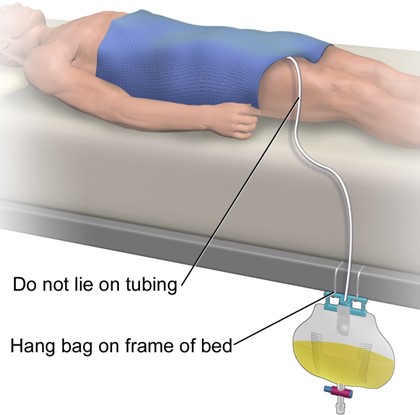A nurse is planning care for a female client who has an indwelling urinary catheter.
Which of the following actions should the nurse include in the plan?
Tape the catheter to the lower abdomen.
Attach the drainage bag to the side rails of the bed.
Empty the drainage bag when it is three-quarters full.
Keep the drainage bag below the level of the bladder.
The Correct Answer is D
This is important to prevent urine from flowing back into the bladder, which can cause infection 1.

Choice A is incorrect because the catheter should be secured to the outer side of the thigh, not taped to the lower abdomen 2.
Choice B is incorrect because attaching the drainage bag to the side rails of the bed can cause it to be above the level of the bladder.
Choice C is incorrect because it is important to empty the drainage bag regularly, not just when it is three-quarters full.
Nursing Test Bank
Naxlex Comprehensive Predictor Exams
Related Questions
Correct Answer is D
Explanation
Step 1: Calculate the total fluid intake. The client received 0.9% sodium chloride 600 mL IV infusion and cefazolin 250 mg in dextrose 5% in water 100 mL intermittent IV bolus. So, the total fluid intake is 600 mL + 100 mL = 700 mL.
Step 2: Calculate the total fluid output. The client had 200 mL emesis, 40 mL voided urine, and 20 mL urine from straight catheterization. So, the total fluid output is 200 mL + 40 mL + 20 mL = 260 mL.
Step 3: Calculate the net fluid intake. The net fluid intake is the total fluid intake minus the total fluid output. So, the net fluid intake is 700 mL - 260 mL = 440 mL.
Therefore, the nurse should record the net fluid intake as 440 mL.
Correct Answer is D
Explanation
This is important to prevent urine from flowing back into the bladder, which can cause infection 1.

Choice A is incorrect because the catheter should be secured to the outer side of the thigh, not taped to the lower abdomen 2.
Choice B is incorrect because attaching the drainage bag to the side rails of the bed can cause it to be above the level of the bladder.
Choice C is incorrect because it is important to empty the drainage bag regularly, not just when it is three-quarters full.
Whether you are a student looking to ace your exams or a practicing nurse seeking to enhance your expertise , our nursing education contents will empower you with the confidence and competence to make a difference in the lives of patients and become a respected leader in the healthcare field.
Visit Naxlex, invest in your future and unlock endless possibilities with our unparalleled nursing education contents today
Report Wrong Answer on the Current Question
Do you disagree with the answer? If yes, what is your expected answer? Explain.
Kindly be descriptive with the issue you are facing.
